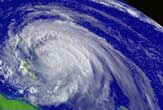A New Spin on Earth's Rotation

We all know that money makes the world go round, but what causes it to change speed ever so slightly? The Earth is known to constantly slow down and speed up, which imperceptibly alters the length of our days.
"We are taught that the day is 24 hours, or 86,400 seconds. That is true, but there are irregularities on the millisecond level," said David Salstein, an atmospheric scientist at Atmospheric and Environmental Research, Inc.
A Russian scientist claimed this week that these irregularities can be used to predict weather and earthquakes.
After long-term observations of tidal oscillations of the Earth's rotation speed and atmospheric processes, N.S. Sidorenkov from the Hydrometeorological Center of Russia has devised a model that can supposedly forecast the weather from rotation data more accurately than current meteorological methods.
"There certainly is an association between weather and rotation," Salstein told LiveScience in a telephone interview.
But Salstein is of the mind that changes in the weather drive the rotational irregularities, not the other way around. He admitted, though, that proving what is the cause and what is the effect is not easy.
At the whim of the wind
Sign up for the Live Science daily newsletter now
Get the world’s most fascinating discoveries delivered straight to your inbox.
The Earth's rotation speed can be measured using different techniques. One of the oldest ways is with multiple radio telescopes all observing the same very distant object. The telescope signals can be combined to give a precise position of the Earth.
More recently, global positioning satellites (GPS) and laser ranging (bouncing a laser beam off of the Moon or a satellite) can also determine the speed with which our planet spins on its axis.
The rotation data shows oscillations over several different timescales. The one with the largest variation is seasonal: Earth slows down in January and February.
"It turns out that during the Northern Hemisphere winter, the winds - which are predominantly west to east - are stronger," Salstein said.
The more forceful winds double the angular momentum of the atmosphere. Angular momentum is a conserved quantity in nature - the example usually given is the spinning ice skater conserving angular momentum by speeding up when she brings her arms in.
In this case, the whole system - comprised of the spinning Earth and swirling atmosphere - adjusts to the blustery winter months by slowing down the solid Earth's rotation. This means the days get longer - by a few thousandths of a second.
The winter in the Southern Hemisphere does not produce the same increase in wind because the bottom of the world is mostly ocean and the temperature swings are, therefore, not as great.
Other associations
There are other smaller oscillations besides the seasonal one. The Madden-Julian cycle, which is a variation in tropical weather patterns that lasts about 30 to 60 days, corresponds to changes in the Earth's rotation.
On longer scales, the length of the day increases slightly during an El Nino - the two- to four-year cycle in Pacific Ocean temperatures that fuels global climate change. This is due to a shift in the Northern Hemisphere's jet stream, which is a high-altitude, fast-moving wind current.
Some have suggested that global warming will slow the planet, but Salstein said "nothing definitive has yet been seen." He believes the warming by itself will not change the rotation speed, unless the poles warm faster than the equator - as some models do predict.
Climate and weather may not be the only phenomena related to rotation. There are indications that changes in the interior of the Earth may alter the spinning speed, as well as the position of the poles. Some scientists claim that December's tsunami-causing Sumatra earthquake resulted in a shortening of the day by 2.68 millionths of a second.
Moreover, the Moon and the Earth are slowly drifting away from each other. To conserve angular momentum, the Earth is slowing down, and the day is lengthening at a rate of about a millisecond per century.
Why it matters
Because the dominant relationship in Salstein's observations is between wind and rotation, he attempts to predict the Earth's rotation from long-range weather forecasts.
This rotation forecast is important to NASA's Jet Propulsion Laboratory because they need an exact reference to send out navigation signals to their spacecraft in the far reaches of the solar system. Although a millisecond difference in the length of the day seems like a small change, "at the radius of Jupiter that will be important," Salstein said.
It may not be so simple to say if weather is causing changes in the rotation, as Salstein presupposes, or if rotation drives shifts in climate, as Sidorenkov claims. Although weather might seem to be immune to millisecond changes in the Earth's rotation, it should be remembered that the Earth's rotation does play an important part in creating general weather patterns.
For instance, the motion of the jet stream and the counterclockwise-moving winds around low-pressure systems in the Northern Hemisphere (opposite in the Southern) are manifestations of the Earth turning underneath the atmosphere.
It may be that rotation and weather are so intricately tied that it may not make sense to speak of cause and effect. The Earth slowing down may drive a change in wind patterns, which causes another alteration to the rotation, which then kicks up more wind, ad infinitum.
Make that Leap
When changes in the length of the day accumulate, it becomes necessary to add a leap second. The organization responsible for keeping track of this is the International Earth Rotation Service (IERS). Since 1972, the IERS has added 22 leap seconds. The last leap second was on Dec. 31, 1998.










